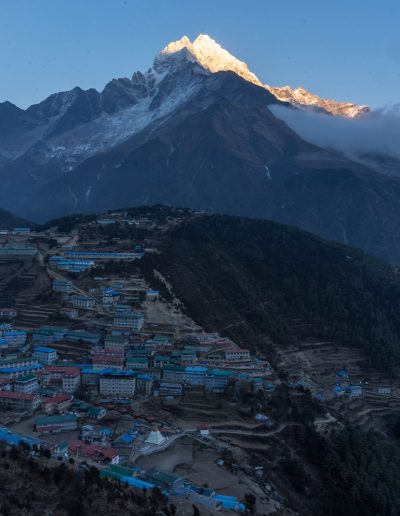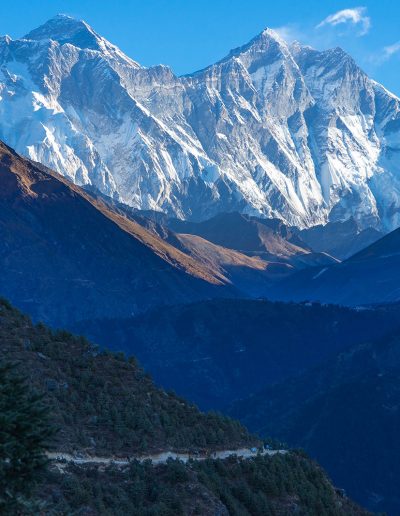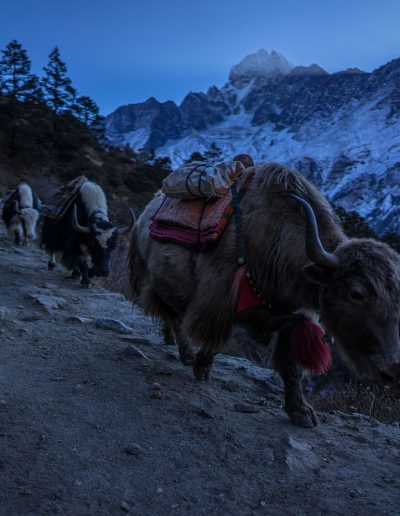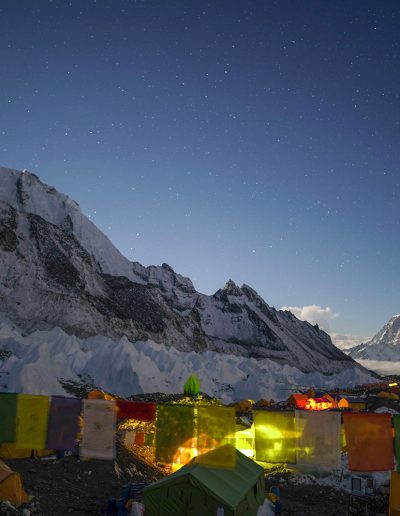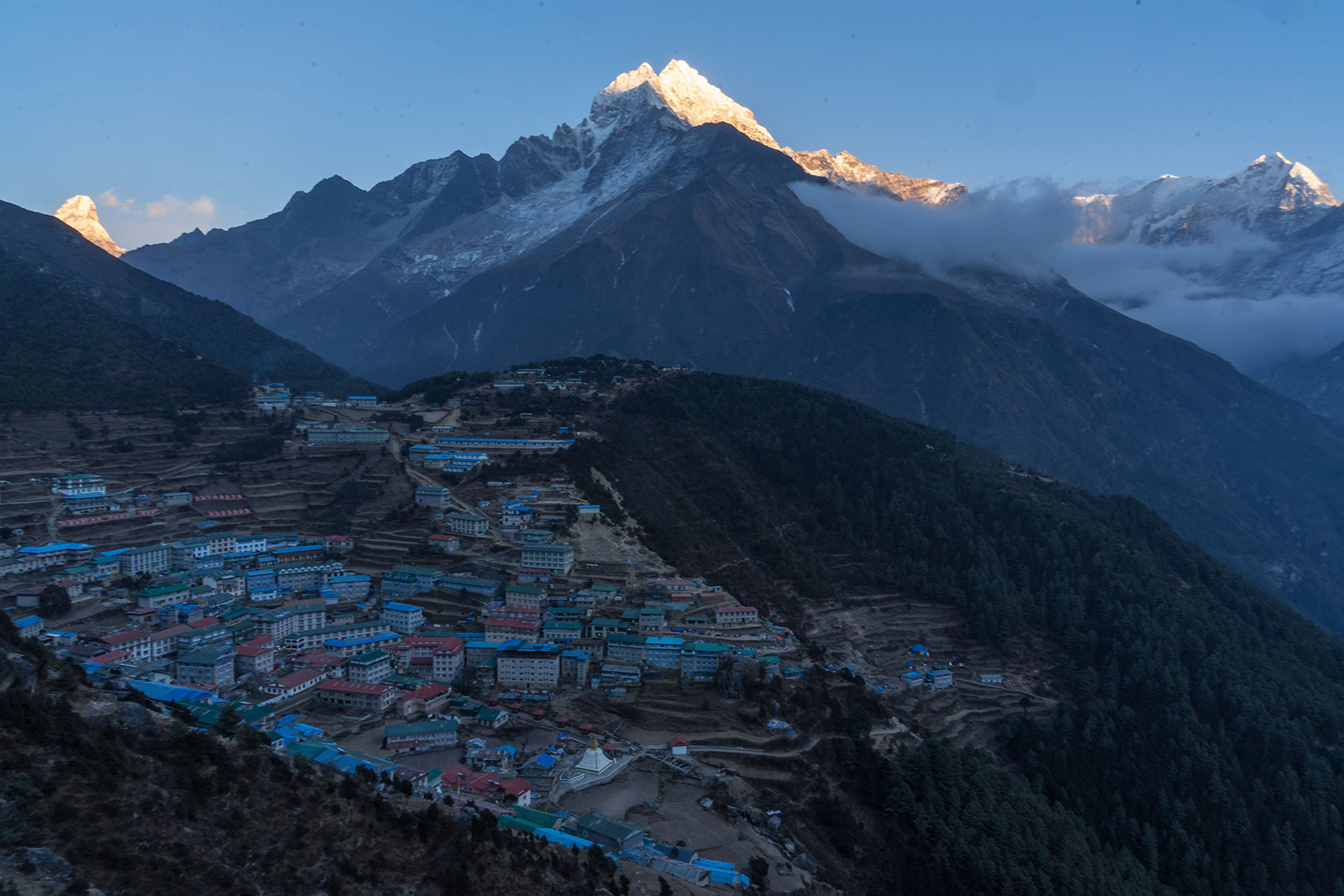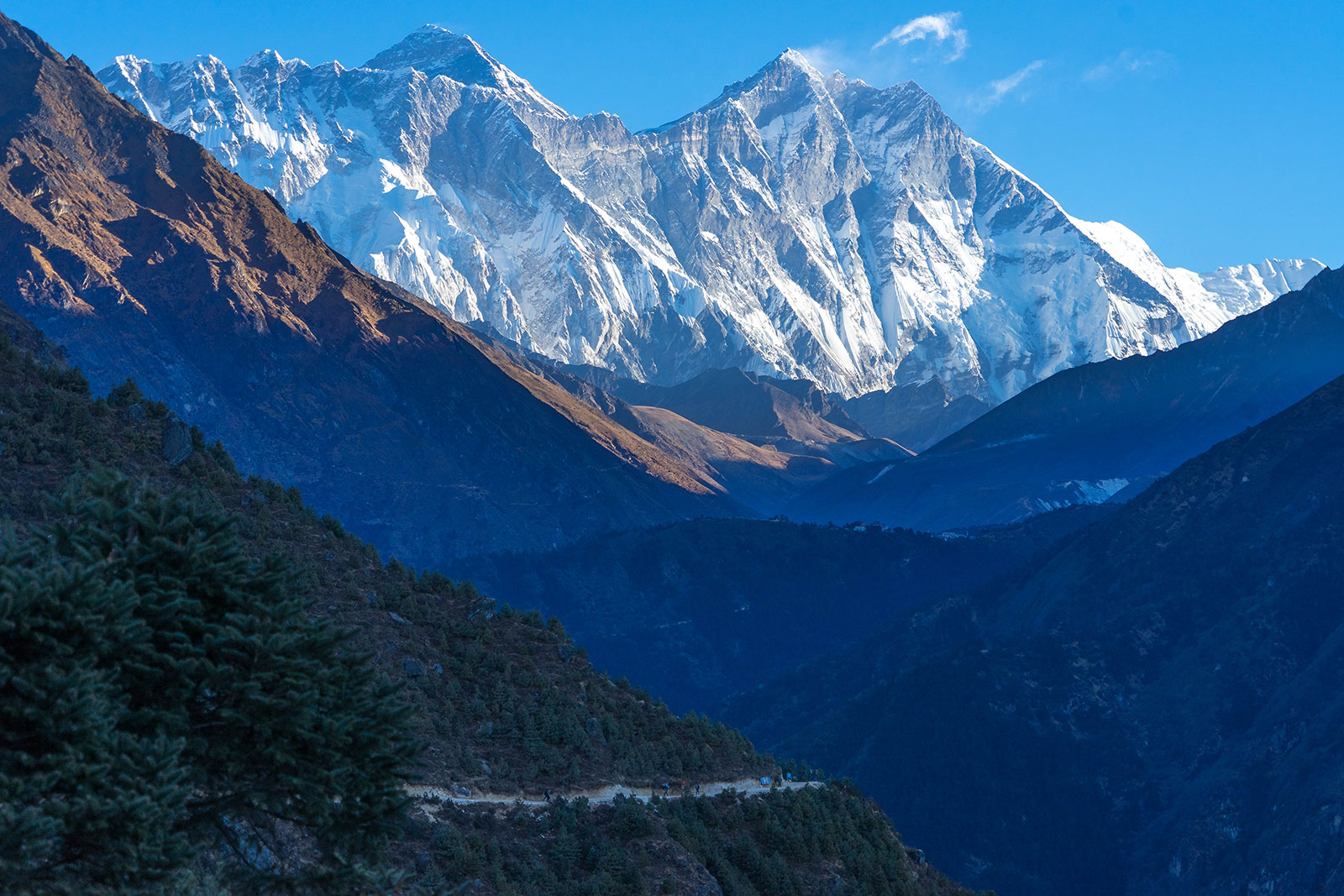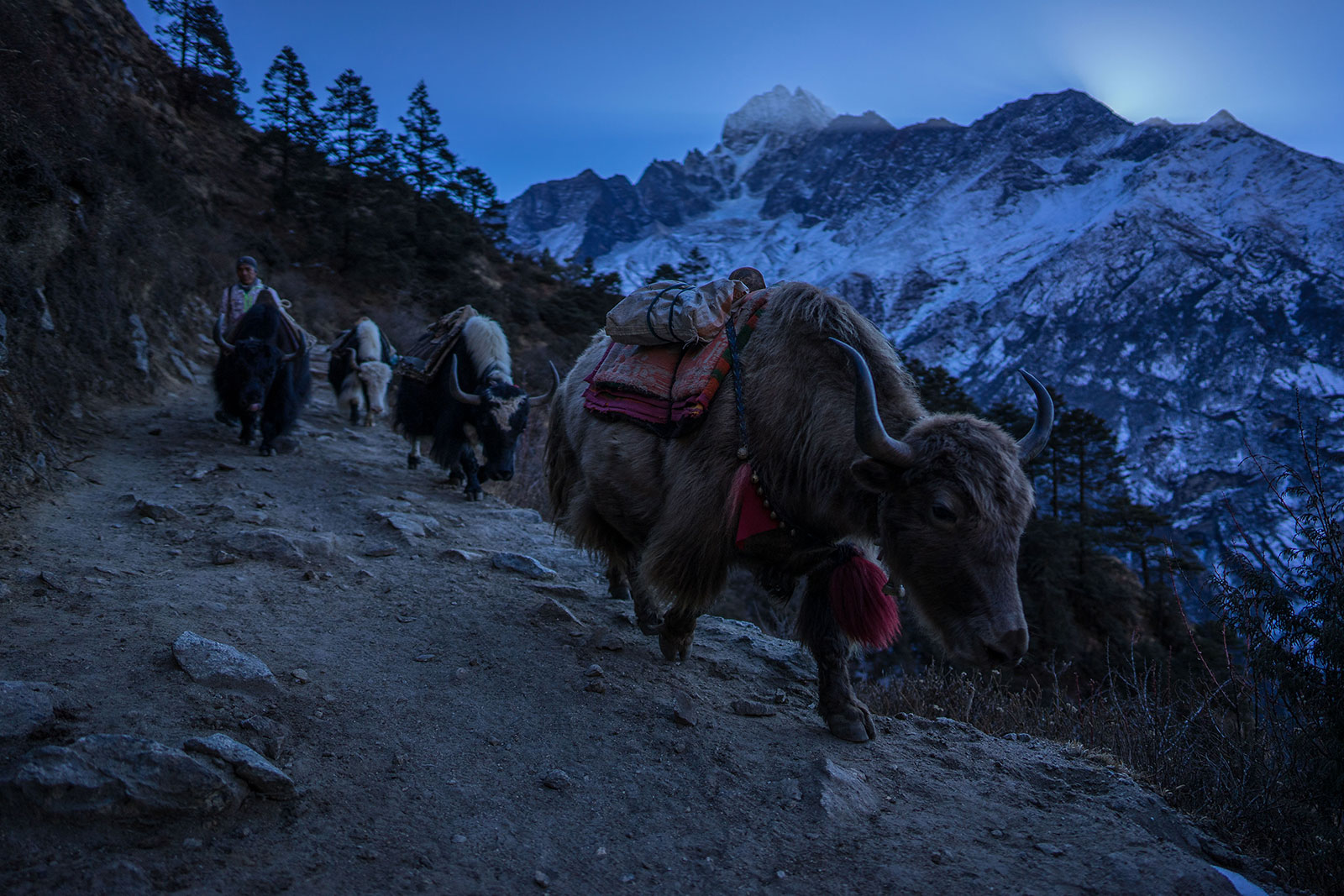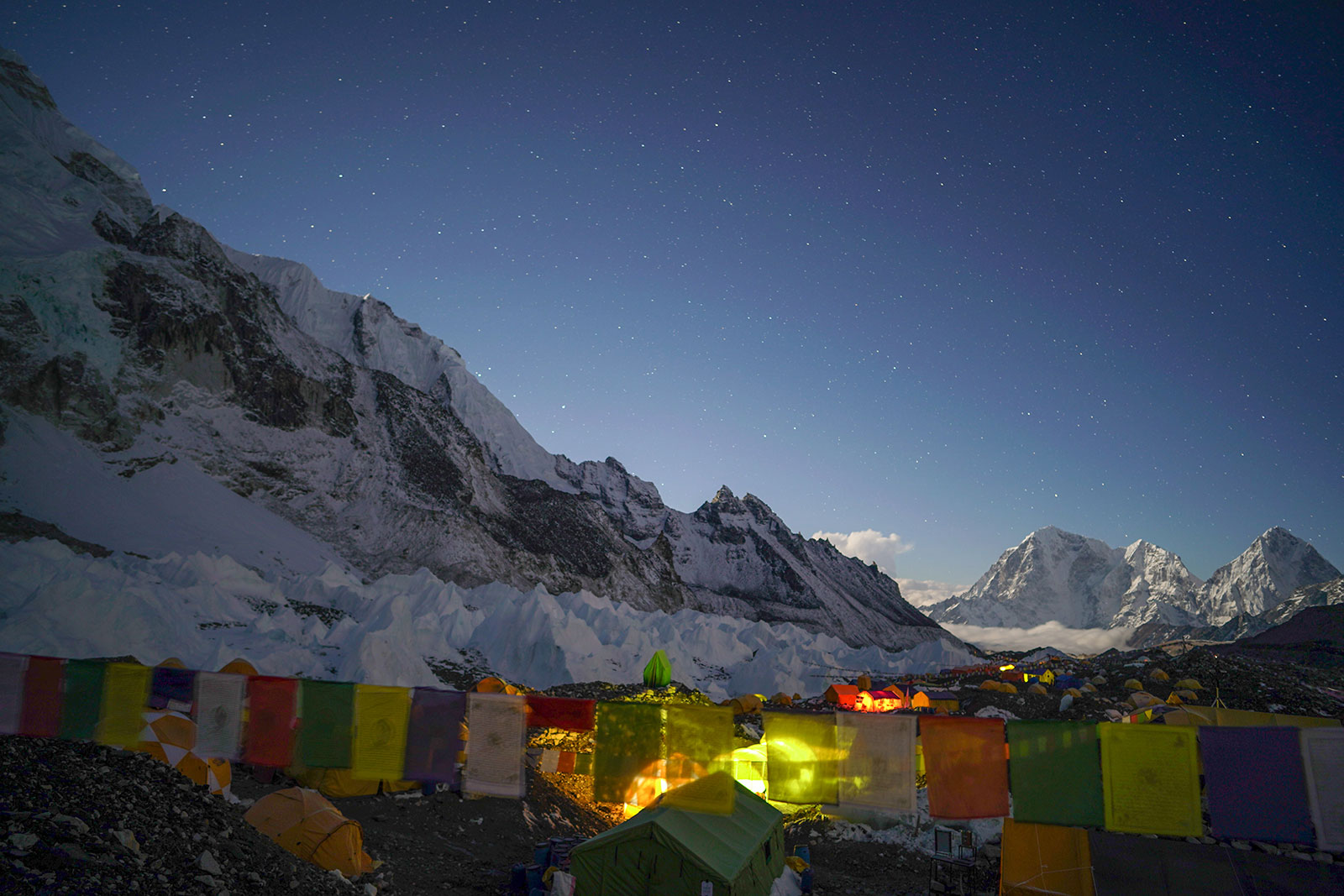Everest Base Camp Trek
Everest Base Camp Trek
DAYS
15
DIFFICULTY
Moderate/Strenuous
MAX ALTITUDE
5,545 M
ACCOMMODATION
Teahouses
DAYS
15
DIFFICULTY
Moderate/ Strenuous
MAX ALTITUDE
5,545 M
ACCOMMODATION
Tea House
Trip Overview
With its ancient culture and the Himalayas as a backdrop, Nepal has long been the destination of choice for travelers in search of adventure. Landlocked between the high plateaus of Tibet to the north and the hot, fertile plains of India to the south, Nepal is a land of ancient history, colorful cultures and people, amazing architecture and stunning scenery.
On this trek, you go from the hustle and bustle of Kathmandu, a cosmopolitan city very much in the 21st century, but still with pockets dating back to ancient times, into the supreme majesty of Nepal’s high Himalayas. The pathways you will tread will not only take you to the foot of the world’s highest mountain through jaw-dropping scenery but will envelop you in the spirit of Nepal and its people. As you pass through villages following traditional trade routes you will be given an insight into life in rural Nepal and marvel at the adaptability, resilience, and tenacity of Nepal’s Sherpa people.
Day 1 : Trek briefing and preparation day
Day 2 : Fly to Lukla (2,886m), trek to Phakding (2,640m) approx 3-4 hours
Day 3 : Trek Phakding to Namche Bazaar (3,440m), approx 5-6 hours
Day 4 : Acclimatisation day in Namche Bazaar and local excursion
Day 5 : Trek Namche Bazaar to Tengboche (3,870m), approx 5-6 hours
Day 6 : Trek Tengboche to Dingboche (4,410m), approx 5-6 hours
Day 7 : Rest at Dingboche for acclimatisation and a local excursion
Day 8 : Trek Dingboche to Lobuche (4,910m) via Dongla (4,620m), approx 6 hours
Day 9 : Trek Lobuche (4,910m) to Gorakshep (5,140m), to Base Camp (5,486) approx 8-9 hours
Day 10 : Trek Gorakshep to Kalapatthar (5,545m) and down to Pheriche (4,243m) approx 9-10 hours
Day 11 : Trek Pheriche to Phortse (3,810m), approx 4 ½ hours
Day 12 : Trek Phortse (3,810m) to Khumjung (3,790m), approx 3 ½ hours
Day 13 : Trek Khumjung to Phakding (2,640m), approx 5 hours
Day 14 : Trek Phakding to Lukla (2,800m), approx 4 hours
Day 15 : Fly Kathmandu
Note: The trek itinerary is a guide only and may be subject to change at short notice
Day 1: Trek briefing and preparation
Day 2: Fly from Kathmandu to Lukla (2,886m), approximately 30 minutes. Our trek to Phakding (2,640m) starts directly from the airport and will take three to four hours. You will trek along a pleasant trail gently descending, with a steep climb from Tarhe Khola, where you have a superb view of the Kusum-Kangru (6,369m). After another short climb, you reach Ghat village, and after another 1 ½ hrs of trekking, you arrive at Phakding village.
Day 3: Trek from Phakding to Namche Bazaar (3,440m), approximately 5-6 hours. After crossing a suspension bridge over the Dudh Kosi River, the walk is pleasant with a few short uphill climbs and then downhill, with magnificent views of Thamserku (6,808m). From the village of Benkar, you will cross a long suspension bridge over the Dudh Koshi River once more and then continue on this trail of trekkers, Ghopkyo (mix of yak and cow) and porters, before finally arriving at the small village of Monjo. Monjo is situated below the magnificent peak of Thamserku and near to the entrance of Sagarmatha National Park. After a few minutes’ walk from Monjo, you will enter the Sagarmatha National Park, where your trekking permit is checked. From here there is a short descent to Jorsalle village, the last village before Namche Bazaar. You will continue to trek by the river until the last bridge over the Imjatse River is reached. From here the walk is along a winding uphill path all the way to Namche Bazaar, with views of Kwangde Peak and its other sister peaks to the east, with Kusum Kangru behind you as you climb higher. There are also views of the Mt. Everest – Nuptse Wall, Lhotse and a closer view of Taweche Peak, which can be seen all the way up to Thop Danda, where there’s a resting stonewall for porters and trekkers. From here, there is still another 1-2 hour walk, which brings you to the famed Namche Bazaar, with its colorful houses situated in an amphitheater shaped bowl. Namche Bazaar is the main trading village in the Khumbu region and holds a busy Saturday market. It is also a meeting place for Hindu traders from the lowlands and the Tibetan yak caravans that have reached the town by crossing the glaciated Nangpa La.
Day 4: Acclimatisation day in Namche Bazaar. Namche is tucked away between two ridges amidst the giant peaks of the Khumbu and has an abundance of lodges, tea shops, and souvenir shops as well as a magnificent outlook. It is an ideal place to spend a rest day for acclimatization to the high altitude before heading off towards Tyangboche. As part of our acclimatization process, we undertake a morning walk, in order to follow the rule of walk high, sleep low. As a group, we will head to Syangboche (3800m) where the Everest View Hotel is situated offering (subject to weather) outstanding views of Everest, Nuptse, Lhotse, Ama Dablam, Thamserku, and Kusum Kangaru. From here we return to Namche for lunch and you are at leisure to spend the afternoon as you wish. For those of you with sufficient energy, you may wish to undertake the short, uphill walk to the Sagarmatha National Park headquarters, a magnificent spot perched on top of Namche Bazaar with spectacular views of the surrounding snow-capped giants and the valleys way down below. There is also an interesting museum with all kinds of information regarding the history of the Himalayas, its geography, culture, mountaineering history and information on flora and fauna of this region.
Day 5: Trek from Namche Bazaar to Tengboche (3,870m), approximately 5-6 hours. The trail leads along a winding path high above the Dudh Koshi with great views of Mt. Everest, Nuptse, Lhotse, Ama Dablam and a close-up view of Thamserku. You will come to a busy place called Shanasa, and in this area, there is a much higher chance of seeing the beautifully colored Danphe Pheasant, the national bird of Nepal, the elusive musk deer and sometimes, even a herd of Himalayan Thar (mountain goat). From Shanasa, the trail steeply drops to a bridge over the Dudh Koshi at Phunki Tenga (3,250m), a small settlement with a couple of teahouses in the midst of the alpine woods of mostly silver fir, blue pines, rhododendron, and some magnolia and birch trees. The village has an excellent place for lunch and you can take a short rest before making the steep climb to Tengboche. The walk from here is strenuous for an hour on a winding trail through shaded woods until a small religious monument of prayer stones covered with rhododendron leaves and junipers is reached. From here the walk is uphill for another hour, with views of Thamserku and Kangtenga. Tengboche is one of the most beautiful places in the Himalayas, and the first thing that you will see is a big Ghompa (monastery) beneath the peak of Ama Dablam, with Everest looming above, the Nuptse wall to the north, Lhotse and Lhotse Shar to the northeast and many more peaks all around you. Tengboche is famous for its legendary monastery, the largest in the Khumbu region. It also has an amazing bakery, offering tempting treats to tired and hungry trekkers.
Day 6: Trek from Tengboche to Dingboche (4,410m), approximately 5-6 hours. Trekking today you gently descend through a forest of birch, fir, juniper and rhododendron and come out at a lovely spot at Deboche (3,650m) with further views of Mt. Ama Dablam, Mt. Everest, Nuptse, and Lhotse. From Deboche you will walk past the long mani prayer wall and the path is gradual until you reach a small bridge over the narrow gorge of the Imjatse River. The walk continues gradually uphill, passing through Pangboche village and then continuing onto Shomare, a small settlement with a fantastic close-up view of Ama-Dabla. From here your journey continues eastwards, after an hour’s walk before a small wooden bridge the road splits two ways and we take the route leading east beneath the towering north face of Ama Dablam. The trail climbs slowly, winding above the Imjatse River until you come to a big mani stupa. From here onwards the walk is fairly moderate as you enter the Imjatse Valley beneath the mighty peaks of Ama Dablam, Nuptse, and Lhotse with views of the eastern snow-capped mountains. Dingboche is a beautiful patchwork of fields enclosed by stone walls protecting the crops of barley and potatoes from the cold winds and grazing animals.
Day 7: Rest at Dingboche for acclimatization and a local excursion. Here you can climb steeply up to Nakartsang Gompa for the rare outstanding view of Mount Makalu (8,463m) along with Lhotse, Island Peak, Baruntse, Ama Dablam and Thamserku or head up the Imja Valley to Chhukung, a small summer settlement at 4,730m, with fantastic views. It is also the staging place for climbers attempting Island Peak.
Day 8: Trek from Dingboche to Lobuche (4,910m) via Dongla (4,620m), approximately 6 hours. Today’s onward journey leads north for about 40-50mins until you come to a mani prayer stupa. The trail is gentle, looking down to Pheriche village below. Today’s walk offers views of the Mt.Tawache, Ama Dablam and to the north Pokalde (5,741m), Kongma-tse (5,820m) and the great wall of Nuptse. After a walk of 1 ½-2hrs, the trail from Pheriche joins another near Dugla (4,595m) before a small wooden bridge over the river of Khumbu glacier. You will stop at Thukla, for lunch, before continuing for an hour up a steep hill to the top. As you summit the hill you enter a memorial ground of prayer flags and monuments dedicated to climbers who have lost their lives attempting to reach the lofty pinnacles of these majestic mountains. From here you have unrivaled views of Mt. Pumori and other peaks west of Everest. The path then climbs gently along the glacier, to eventually reach the cluster of houses at Lobuche, hidden and sheltered from the wind.
Day 9: Trek from Lobuche (4,910m) to Gorakshep (5,140m), approximately 3 ½-4 hours and then on to Base Camp (5,486m), a further 4 ½-5 hour round trip. The first hour’s walk is gradual, followed by a short 20 minutes climb to the top of the pass. The walk from here follows a rocky moraine path, and as you walk you can see the icy, glacial pond and icebergs down below of Khumbu glacier. After the last rocky moraine dunes, a short downhill walk brings you to Gorakshep on a flat field below Kalapatthar (5,545m) and Mt.Pumori (7,145m). Gorakshep has two teahouses, and it was used as a base camp in the early 50’s Edmund Hilary expedition to Mt. Everest. You will have lunch and a rest at Gorakshep, and for those who feel up to it, you can walk to your ultimate destination, Everest Base Camp. The walk is strenuous due to the high altitude and thin air and it passes over rocky dunes, moraine, and streams. A great view of the Khumbu Icefall awaits you.
Day 10: Trek from Gorakshep to Kalapatthar (5,545m) for sunrise and down to Pheriche (4,243m), approximately 9-10 hours in total. This morning you have the option to ascend to the summit of Kalapatthar for sunrise. A few minutes of easy walking on the sandy fields brings you to the base of the peak, then a steep climb brings you to a near level field. The walk from here is gradual until you reach a rocky spot after approx. 1 ½-2 hours. From here, it’s another steep climb to the top of about 2-3 hrs. At the top of Kalapatthar is a small rocky peak on the southwest ridge of Mt.Pumori, the view from here is beyond the imagination, as Everest looks within a stones throws distance. Between the summit of Nuptse, Lho-la, and Lhotse, the panoramic view from this spot is something to cherish, and you’ll feel the hard climb was worth it, as you get the feeling of being on top of the world. All of the high snow-capped giants that dominate, will be all around you. To the south, the Khumbu Glacier sweeps below you and you can also see Everest Base Camp nestled on its moraine. From here you will head back down to Gorakshep for breakfast and then on to Pheriche. Pheriche is known as the Windy Town and is home to the Himalayan Rescue Association Aid Post, manned by foreign volunteer doctors. Here you can see the perpendicular walls of Cholatse and Tawache.
Day 11: Trek from Pheriche to Phortse (3,810m), approximately 4 ½ hours. The trail descends to Pangboche and then wiggles up and down to Phortse. On the way, there is an opportunity to see wildlife in and around the area such as mountain goats, musk deer and many species of Himalayan birds. There are village monasteries in Pangboche and Phortse rich in the cultural heritage of the Sherpa people. The old monastery in Pangboche is believed to have been established during the 16th century and Pangboche village is known to have the highest permanent settlement throughout the year.
Day 12: Trek from Phortse (3,810m) to Khumjung (3,790m), approximately 3 ½ hours. The trail here descends for nearly twenty minutes and ascends up steeply for almost one hour to Mongla (4,000m). From this spot, you can see the panoramic view of Ama Dablam, Thamserku, Kusum Kangaru, Konde-Ri, and Tawache Peak. The trail then follows an up and down route to Khumjung. Khumjung village is believed to have the largest settlement of the Khumbu region. There is a well-equipped high school and hospital built by the late Edmund Hillary in the 1960s. Not limited to this, the skull of a Yeti is housed in an old monastery.
Day 13: Trek from Khumjung to Phakding (2,640m), approximately 5 hours. From Khumjung, you will head uphill out of the village onto high pastures. From here you will walk across the pastures to Syangboche and then down to Namche Bazaar for lunch. From Namche, you will retrace your day 2 route back down to Phakding.
Day 14: Trek from Phakding to Lukla (2,800m), approximately 4 hours. This day the trail gradually ascends back to Lukla.
Day 15: Early morning flight back to Kathmandu taking approximately 30 minutes.
Note: The trek itinerary is a guide only and may be subject to change at short notice
Himalayan Quests uses a layering system where different pieces of clothing are worn together or separately to achieve optimum body temperature control. The upper body garments listed here are either synthetic or merino wool garments that retain their insulating properties when wet, or nylon or Gore-Tex layers which help prevent heat loss by cutting wind, rain, and snow.
This is a guideline only
| UPPER BODY LAYERS | ||
| Equipment | Quantity | Comments |
| T-Shirts – walking | 2 | We recommend merino wool, Capilene or other synthetic fabric as they wick away the moisture and dry quickly. No cotton. |
| T-shirt – sleeping | 1 | This can be cotton |
| Base layers (ie thermal top) | 1 | Lightweight or mid-weight long-sleeved t-shirt of merino wool, polyester, Capilene, or Polartec power dry |
| Top insulating Layers | 1 | Mid-weight fleece that can be worn over other layers |
| Fleece Vest | 1 | |
| Rain jacket | 1 | |
| Down Jacket | 1 | |
| LOWER BODY LAYERS | ||
| Equipment | Quantity | Comments |
| Underwear | Sufficient for the trek (remember you can wash them) | |
| Thermal long johns/long underwear | 1 | |
| Trekking Trousers | 2 | Lightweight quick-dry trousers (no cotton). Zip offs are good |
| Evening/sleeping trousers | 1 optional | 1 pair of lightweight tracksuit bottoms (sweat pants) or yoga style trousers for evening wear and sleeping in. No jeans. |
| Hiking Shorts | 1 | If no zip-off trousers. Below the knee for ladies |
| Rain Pants | 1 | |
| PACKS & BAGS | ||
| Equipment | Quantity | Comments |
| Day pack | 1 | Approx. 35ltrs. HQ will provide you with a duffle bag for your trekking gear |
| Sleeping bag with compression sack | 1 | Minimum 3 season |
| Sleeping bag liner | 1 | Optional |
FOOTWEAR
| Equipment | Quantity | Comments |
| Hiking boots | 1 | Must be well worn and comfortable with ankle support |
| Socks | 3 | |
| Flip flops/Camp shoes | 1 | Lightweight for evening use |
| MISCELLANEOUS ITEMS | ||
| Equipment | Quantity | Comments |
| Water bottles | 2 | One liter each, Nalgene or Sig style or a bladder if preferred |
| Water purification drops | 1 | Cheap and easy to buy in Kathmandu (Piyus) |
| Lip Balm | 1 | With SPF factor |
| Sunscreen | 1 | We recommend SPF 30 or greater |
| Mosquito repellent | 1 | |
| Personal first aid kit | 1 | To include any prescribed medications |
| Sunglasses | 1 | |
| Bandana/Buff | 1 | Useful for a variety of purposes. |
| Flashlight /head torch | 1 | Head torch is best as it leaves your hands free + extra batteries |
| Travel towel | 1 | Lightweight and compact |
| Wash kit | Travel size items for the trek & eco friendly if possible | |
| Instant Hand Sanitizer | 1 | Alcohol-based for keeping hands clean |
| Sun hat | 1 | |
| Warm hat | 1 | |
| Gloves | 1 | |
| Trekking poles | Optional | |
| Trekking snacks | Good selection available in KTM | |
| Camera | With charger &/or extra batteries | |
| Toilet paper & rubbish bag | ||
| Book/journal | ||
| Pack of cards/travel game | 1 | For evening entertainment |
| Passport photos | Always useful and a must-have if you want a local sim card | |
| Photocopies of all your important documents | ||
| A great sense of humor & a positive attitude | Essential – don’t come without it!! J | |
Your trek cost includes:
- Pre-trip advice and detailed information
- Expert trip leadership and motivated staff for the duration of the trek
- Airport transfers in Nepal (where applicable)
- 2 nights accommodation pre-trek & 1-night post-trek in Kathmandu
- 1-night accommodation pre or post-trek in Pokhara (where applicable)
- Transportation to and from trek start and finish for you and your trekking team (different budget options available)
- Basic teahouse/lodge/camping accommodation during the trek on a twin sharing basis
- During the trek all meals on a full board basis (breakfast, lunch, and dinner) to include tea/coffee during the meals, but excluding any drinks outside of the meal times
- All permits, conservation area, and restricted area fees
- Porters
- Insurance and equipment for Nepali staff
- Rescue assistance
- Group medical kit
Your trek cost does NOT include:
- International flights to and from Kathmandu, Nepal
- Visa for Nepal
- Travel insurance (insurance to include evacuation is mandatory. Please make sure you are covered to the correct altitude)
- Personal expenses such as fizzy drinks, chocolate, gifts, snacks, hot showers during the trek, etc.
- Meals unless specified
- Sightseeing
- Gratuities
- Excess baggage on internal flights
- Charges incurred as a result of delays beyond the control of Himalayan Quests
Day 1 : Trek briefing and preparation day
Day 2 : Fly to Lukla (2,886m), trek to Phakding (2,640m) approx 3-4 hours
Day 3 : Trek Phakding to Namche Bazaar (3,440m), approx 5-6 hours
Day 4 : Acclimatisation day in Namche Bazaar and local excursion
Day 5 : Trek Namche Bazaar to Tengboche (3,870m), approx 5-6 hours
Day 6 : Trek Tengboche to Dingboche (4,410m), approx 5-6 hours
Day 7 : Rest at Dingboche for acclimatisation and a local excursion
Day 8 : Trek Dingboche to Lobuche (4,910m) via Dongla (4,620m), approx 6 hours
Day 9 : Trek Lobuche (4,910m) to Gorakshep (5,140m), to Base Camp (5,486) approx 8-9 hours
Day 10 : Trek Gorakshep to Kalapatthar (5,545m) and down to Pheriche (4,243m) approx 9-10 hours
Day 11 : Trek Pheriche to Phortse (3,810m), approx 4 ½ hours
Day 12 : Trek Phortse (3,810m) to Khumjung (3,790m), approx 3 ½ hours
Day 13 : Trek Khumjung to Phakding (2,640m), approx 5 hours
Day 14 : Trek Phakding to Lukla (2,800m), approx 4 hours
Day 15 : Fly Kathmandu
Note: The trek itinerary is a guide only and may be subject to change at short notice
Day 1: Trek briefing and preparation
Day 2: Fly from Kathmandu to Lukla (2,886m), approximately 30 minutes. Our trek to Phakding (2,640m) starts directly from the airport and will take three to four hours. You will trek along a pleasant trail gently descending, with a steep climb from Tarhe Khola, where you have a superb view of the Kusum-Kangru (6,369m). After another short climb, you reach Ghat village, and after another 1 ½ hrs of trekking, you arrive at Phakding village.
Day 3: Trek from Phakding to Namche Bazaar (3,440m), approximately 5-6 hours. After crossing a suspension bridge over the Dudh Kosi River, the walk is pleasant with a few short uphill climbs and then downhill, with magnificent views of Thamserku (6,808m). From the village of Benkar, you will cross a long suspension bridge over the Dudh Koshi River once more and then continue on this trail of trekkers, Ghopkyo (mix of yak and cow) and porters, before finally arriving at the small village of Monjo. Monjo is situated below the magnificent peak of Thamserku and near to the entrance of Sagarmatha National Park. After a few minutes’ walk from Monjo, you will enter the Sagarmatha National Park, where your trekking permit is checked. From here there is a short descent to Jorsalle village, the last village before Namche Bazaar. You will continue to trek by the river until the last bridge over the Imjatse River is reached. From here the walk is along a winding uphill path all the way to Namche Bazaar, with views of Kwangde Peak and its other sister peaks to the east, with Kusum Kangru behind you as you climb higher. There are also views of the Mt. Everest – Nuptse Wall, Lhotse and a closer view of Taweche Peak, which can be seen all the way up to Thop Danda, where there’s a resting stonewall for porters and trekkers. From here, there is still another 1-2 hour walk, which brings you to the famed Namche Bazaar, with its colorful houses situated in an amphitheater shaped bowl. Namche Bazaar is the main trading village in the Khumbu region and holds a busy Saturday market. It is also a meeting place for Hindu traders from the lowlands and the Tibetan yak caravans that have reached the town by crossing the glaciated Nangpa La.
Day 4: Acclimatisation day in Namche Bazaar. Namche is tucked away between two ridges amidst the giant peaks of the Khumbu and has an abundance of lodges, tea shops, and souvenir shops as well as a magnificent outlook. It is an ideal place to spend a rest day for acclimatization to the high altitude before heading off towards Tyangboche. As part of our acclimatization process, we undertake a morning walk, in order to follow the rule of walk high, sleep low. As a group, we will head to Syangboche (3800m) where the Everest View Hotel is situated offering (subject to weather) outstanding views of Everest, Nuptse, Lhotse, Ama Dablam, Thamserku, and Kusum Kangaru. From here we return to Namche for lunch and you are at leisure to spend the afternoon as you wish. For those of you with sufficient energy, you may wish to undertake the short, uphill walk to the Sagarmatha National Park headquarters, a magnificent spot perched on top of Namche Bazaar with spectacular views of the surrounding snow-capped giants and the valleys way down below. There is also an interesting museum with all kinds of information regarding the history of the Himalayas, its geography, culture, mountaineering history and information on flora and fauna of this region.
Day 5: Trek from Namche Bazaar to Tengboche (3,870m), approximately 5-6 hours. The trail leads along a winding path high above the Dudh Koshi with great views of Mt. Everest, Nuptse, Lhotse, Ama Dablam and a close-up view of Thamserku. You will come to a busy place called Shanasa, and in this area, there is a much higher chance of seeing the beautifully colored Danphe Pheasant, the national bird of Nepal, the elusive musk deer and sometimes, even a herd of Himalayan Thar (mountain goat). From Shanasa, the trail steeply drops to a bridge over the Dudh Koshi at Phunki Tenga (3,250m), a small settlement with a couple of teahouses in the midst of the alpine woods of mostly silver fir, blue pines, rhododendron, and some magnolia and birch trees. The village has an excellent place for lunch and you can take a short rest before making the steep climb to Tengboche. The walk from here is strenuous for an hour on a winding trail through shaded woods until a small religious monument of prayer stones covered with rhododendron leaves and junipers is reached. From here the walk is uphill for another hour, with views of Thamserku and Kangtenga. Tengboche is one of the most beautiful places in the Himalayas, and the first thing that you will see is a big Ghompa (monastery) beneath the peak of Ama Dablam, with Everest looming above, the Nuptse wall to the north, Lhotse and Lhotse Shar to the northeast and many more peaks all around you. Tengboche is famous for its legendary monastery, the largest in the Khumbu region. It also has an amazing bakery, offering tempting treats to tired and hungry trekkers.
Day 6: Trek from Tengboche to Dingboche (4,410m), approximately 5-6 hours. Trekking today you gently descend through a forest of birch, fir, juniper and rhododendron and come out at a lovely spot at Deboche (3,650m) with further views of Mt. Ama Dablam, Mt. Everest, Nuptse, and Lhotse. From Deboche you will walk past the long mani prayer wall and the path is gradual until you reach a small bridge over the narrow gorge of the Imjatse River. The walk continues gradually uphill, passing through Pangboche village and then continuing onto Shomare, a small settlement with a fantastic close-up view of Ama-Dabla. From here your journey continues eastwards, after an hour’s walk before a small wooden bridge the road splits two ways and we take the route leading east beneath the towering north face of Ama Dablam. The trail climbs slowly, winding above the Imjatse River until you come to a big mani stupa. From here onwards the walk is fairly moderate as you enter the Imjatse Valley beneath the mighty peaks of Ama Dablam, Nuptse, and Lhotse with views of the eastern snow-capped mountains. Dingboche is a beautiful patchwork of fields enclosed by stone walls protecting the crops of barley and potatoes from the cold winds and grazing animals.
Day 7: Rest at Dingboche for acclimatization and a local excursion. Here you can climb steeply up to Nakartsang Gompa for the rare outstanding view of Mount Makalu (8,463m) along with Lhotse, Island Peak, Baruntse, Ama Dablam and Thamserku or head up the Imja Valley to Chhukung, a small summer settlement at 4,730m, with fantastic views. It is also the staging place for climbers attempting Island Peak.
Day 8: Trek from Dingboche to Lobuche (4,910m) via Dongla (4,620m), approximately 6 hours. Today’s onward journey leads north for about 40-50mins until you come to a mani prayer stupa. The trail is gentle, looking down to Pheriche village below. Today’s walk offers views of the Mt.Tawache, Ama Dablam and to the north Pokalde (5,741m), Kongma-tse (5,820m) and the great wall of Nuptse. After a walk of 1 ½-2hrs, the trail from Pheriche joins another near Dugla (4,595m) before a small wooden bridge over the river of Khumbu glacier. You will stop at Thukla, for lunch, before continuing for an hour up a steep hill to the top. As you summit the hill you enter a memorial ground of prayer flags and monuments dedicated to climbers who have lost their lives attempting to reach the lofty pinnacles of these majestic mountains. From here you have unrivaled views of Mt. Pumori and other peaks west of Everest. The path then climbs gently along the glacier, to eventually reach the cluster of houses at Lobuche, hidden and sheltered from the wind.
Day 9: Trek from Lobuche (4,910m) to Gorakshep (5,140m), approximately 3 ½-4 hours and then on to Base Camp (5,486m), a further 4 ½-5 hour round trip. The first hour’s walk is gradual, followed by a short 20 minutes climb to the top of the pass. The walk from here follows a rocky moraine path, and as you walk you can see the icy, glacial pond and icebergs down below of Khumbu glacier. After the last rocky moraine dunes, a short downhill walk brings you to Gorakshep on a flat field below Kalapatthar (5,545m) and Mt.Pumori (7,145m). Gorakshep has two teahouses, and it was used as a base camp in the early 50’s Edmund Hilary expedition to Mt. Everest. You will have lunch and a rest at Gorakshep, and for those who feel up to it, you can walk to your ultimate destination, Everest Base Camp. The walk is strenuous due to the high altitude and thin air and it passes over rocky dunes, moraine, and streams. A great view of the Khumbu Icefall awaits you.
Day 10: Trek from Gorakshep to Kalapatthar (5,545m) for sunrise and down to Pheriche (4,243m), approximately 9-10 hours in total. This morning you have the option to ascend to the summit of Kalapatthar for sunrise. A few minutes of easy walking on the sandy fields brings you to the base of the peak, then a steep climb brings you to a near level field. The walk from here is gradual until you reach a rocky spot after approx. 1 ½-2 hours. From here, it’s another steep climb to the top of about 2-3 hrs. At the top of Kalapatthar is a small rocky peak on the southwest ridge of Mt.Pumori, the view from here is beyond the imagination, as Everest looks within a stones throws distance. Between the summit of Nuptse, Lho-la, and Lhotse, the panoramic view from this spot is something to cherish, and you’ll feel the hard climb was worth it, as you get the feeling of being on top of the world. All of the high snow-capped giants that dominate, will be all around you. To the south, the Khumbu Glacier sweeps below you and you can also see Everest Base Camp nestled on its moraine. From here you will head back down to Gorakshep for breakfast and then on to Pheriche. Pheriche is known as the Windy Town and is home to the Himalayan Rescue Association Aid Post, manned by foreign volunteer doctors. Here you can see the perpendicular walls of Cholatse and Tawache.
Day 11: Trek from Pheriche to Phortse (3,810m), approximately 4 ½ hours. The trail descends to Pangboche and then wiggles up and down to Phortse. On the way, there is an opportunity to see wildlife in and around the area such as mountain goats, musk deer and many species of Himalayan birds. There are village monasteries in Pangboche and Phortse rich in the cultural heritage of the Sherpa people. The old monastery in Pangboche is believed to have been established during the 16th century and Pangboche village is known to have the highest permanent settlement throughout the year.
Day 12: Trek from Phortse (3,810m) to Khumjung (3,790m), approximately 3 ½ hours. The trail here descends for nearly twenty minutes and ascends up steeply for almost one hour to Mongla (4,000m). From this spot, you can see the panoramic view of Ama Dablam, Thamserku, Kusum Kangaru, Konde-Ri, and Tawache Peak. The trail then follows an up and down route to Khumjung. Khumjung village is believed to have the largest settlement of the Khumbu region. There is a well-equipped high school and hospital built by the late Edmund Hillary in the 1960s. Not limited to this, the skull of a Yeti is housed in an old monastery.
Day 13: Trek from Khumjung to Phakding (2,640m), approximately 5 hours. From Khumjung, you will head uphill out of the village onto high pastures. From here you will walk across the pastures to Syangboche and then down to Namche Bazaar for lunch. From Namche, you will retrace your day 2 route back down to Phakding.
Day 14: Trek from Phakding to Lukla (2,800m), approximately 4 hours. This day the trail gradually ascends back to Lukla.
Day 15: Early morning flight back to Kathmandu taking approximately 30 minutes.
Note: The trek itinerary is a guide only and may be subject to change at short notice
Trekking Gear List
Himalayan Quests uses a layering system where different pieces of clothing are worn together or separately to achieve optimum body temperature control. The upper body garments listed here are either synthetic or merino wool garments which retain their insulating properties when wet, or nylon or Gore-Tex layers which help prevent heat loss by cutting wind, rain and snow.
THIS IS A GUIDELINE ONLY
UPPER BODY LAYERS
- T Shirts – walking 2 Merino wool, Capilene or other synthetic, wicking fabric. No cotton
- T-shirt – sleeping 1 Can be cotton
- Base layers 1 Light weight or mid weight thermal long sleeved t-shirt
- Top insulating Layers 1 Mid weight fleece that can be worn over other layers
- Fleece Vest 1
- Rain jacket 1
- Down jacket 1
LOWER BODY LAYERS
- Underwear Sufficient for trek (remember you can wash them)
- Thermal long underwear 1
- Trekking Trousers 2 Lightweight quick dry trousers (no cotton). Zip-offs are good
- Hiking Shorts 1 If no zip-off trousers. Below the knee for ladies
- Rain Pants 1
PACKS & BAGS
- Day pack 1 35ltrs. HQ will provide you with a duffle bag for your trekking gear
- Sleeping bag & compression sack 1 Minimum 3 season
FOOTWEAR
- Hiking boots 1 Must be well worn and comfortable with ankle support
- Socks 3 or 4
- Flip flops/Camp shoes 1 Lightweight for evening use
MISCELLANEOUS ITEMS
- Water bottles 2 One litre each, Nalgene or Sig style or a bladder if preferred
- Water purification drops Cheap and easy to buy in Kathmandu (Piyus)
- Sunscreen We recommend SPF 30 or greater
- Lip Balm With SPF factor
- Personal first aid kit To include any prescribed medications
- Sunglasses
- Bandana/Buff
- Flash light /head torch Head torch is best as it leaves your hands free + extra batteries
- Travel towel Lightweight and compact
- Wash kit Travel size items for the trek & eco friendly if possible
- Hand Sanitizer Alcohol-based for keeping hands clean
- Sun hat
- Warm hat
- Gloves
- Trekking poles Optional, but advised if you have dodgy knees
- Toilet paper & rubbish bag
- Trekking snacks Good selection available in KTM
- Camera With charger &/or extra batteries
- Book/journal
- Pack of cards/travel game For evening entertainment
- Mosquito repellent
- Passport photos Always useful and a must have if you want a local sim card
- Photocopies of all your important documents
- A great sense of humour & positive attitude Essential – don’t come without it!! J
Much of the above equipment can be bought cheaply in Kathmandu. You do not need to spend a fortune on gear.
Your trek cost includes:
- Pre-trip advice and detailed information
- Expert trip leadership and motivated staff for the duration of the trek
- Airport transfers in Nepal (where applicable)
- 2 nights accommodation pre-trek & 1-night post-trek in Kathmandu
- 1-night accommodation pre or post-trek in Pokhara (where applicable)
- Transportation to and from trek start and finish for you and your trekking team (different budget options available)
- Basic teahouse/lodge/camping accommodation during the trek on a twin sharing basis
- During the trek all meals on a full board basis (breakfast, lunch, and dinner) to include tea/coffee during the meals, but excluding any drinks outside of the meal times
- All permits, conservation area, and restricted area fees
- Porters
- Insurance and equipment for Nepali staff
- Rescue assistance
- Group medical kit
Your trek cost does NOT include:
- International flights to and from Kathmandu, Nepal
- Visa for Nepal
- Travel insurance (insurance to include evacuation is mandatory. Please make sure you are covered to the correct altitude)
- Personal expenses such as fizzy drinks, chocolate, gifts, snacks, hot showers during the trek, etc.
- Meals unless specified
- Sightseeing
- Gratuities
- Excess baggage on internal flights
- Charges incurred as a result of delays beyond the control of Himalayan Quests
Similar Trips
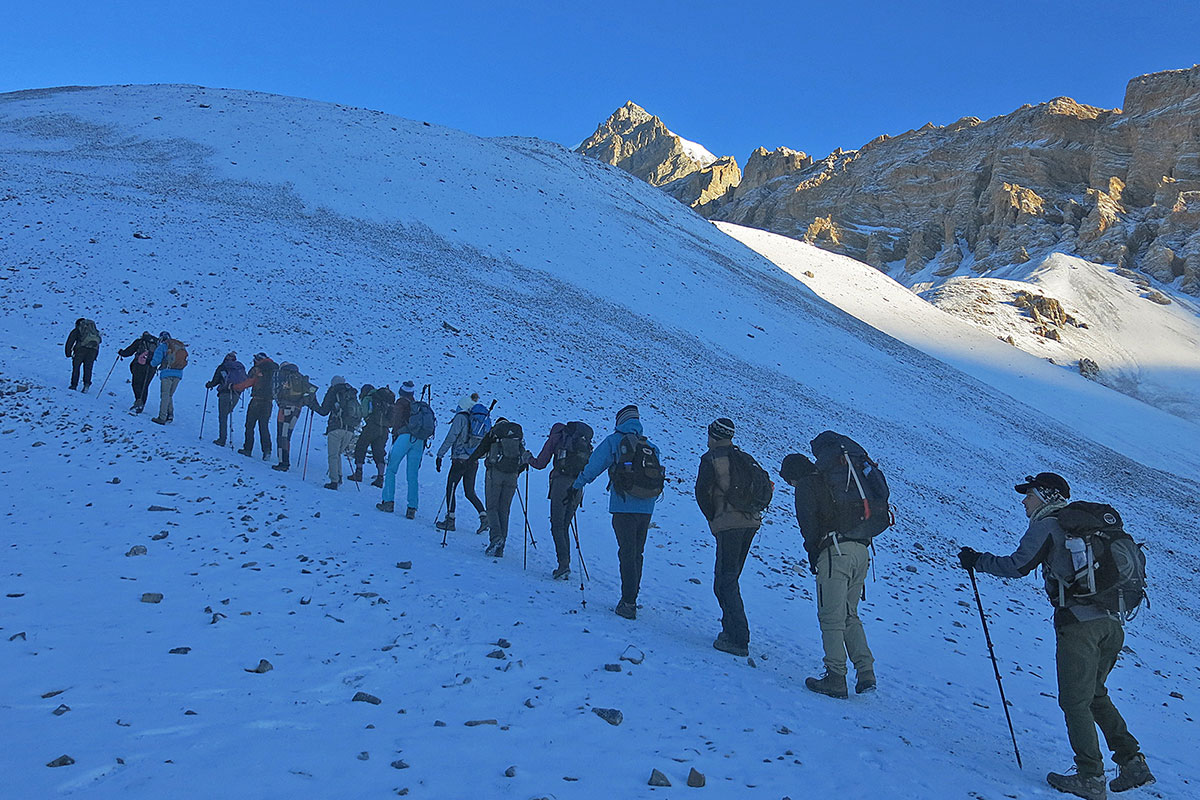
Annapurna Circuit Trek
15 Days
Starting in the lush semi-tropical foothills, you will climb across the main Himalayan range up to the rain shadow high plateau in the Buddhist north and back down through ancient villages and the world’s deepest gorge, the Kali Gandaki Gorge.
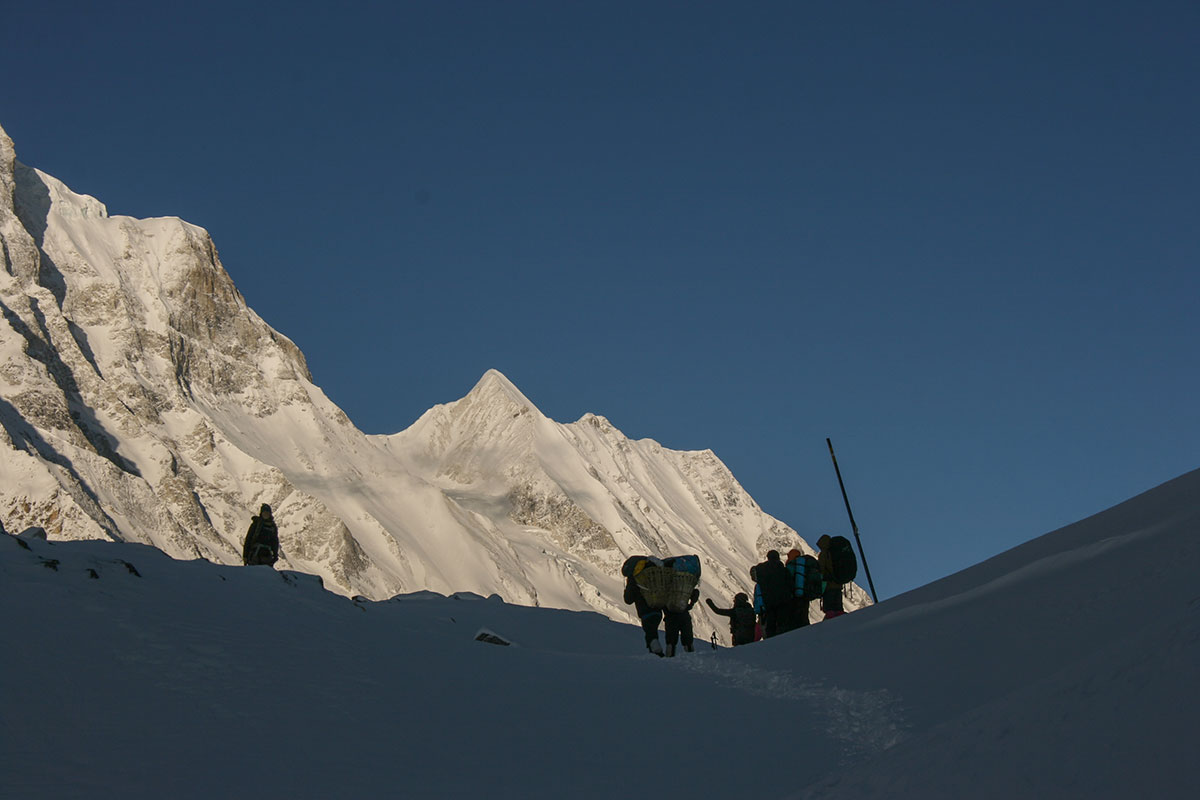
Manaslu Circuit Trek
18 Days
The Manaslu Circuit Trek over the Larky La Pass is one of Nepal’s best-kept secrets. Following remote trails which are little touched by the modern world and which see relatively few visitors throughout the year, it offers beautiful views of the Himalayan range, with the magnificent Manaslu.
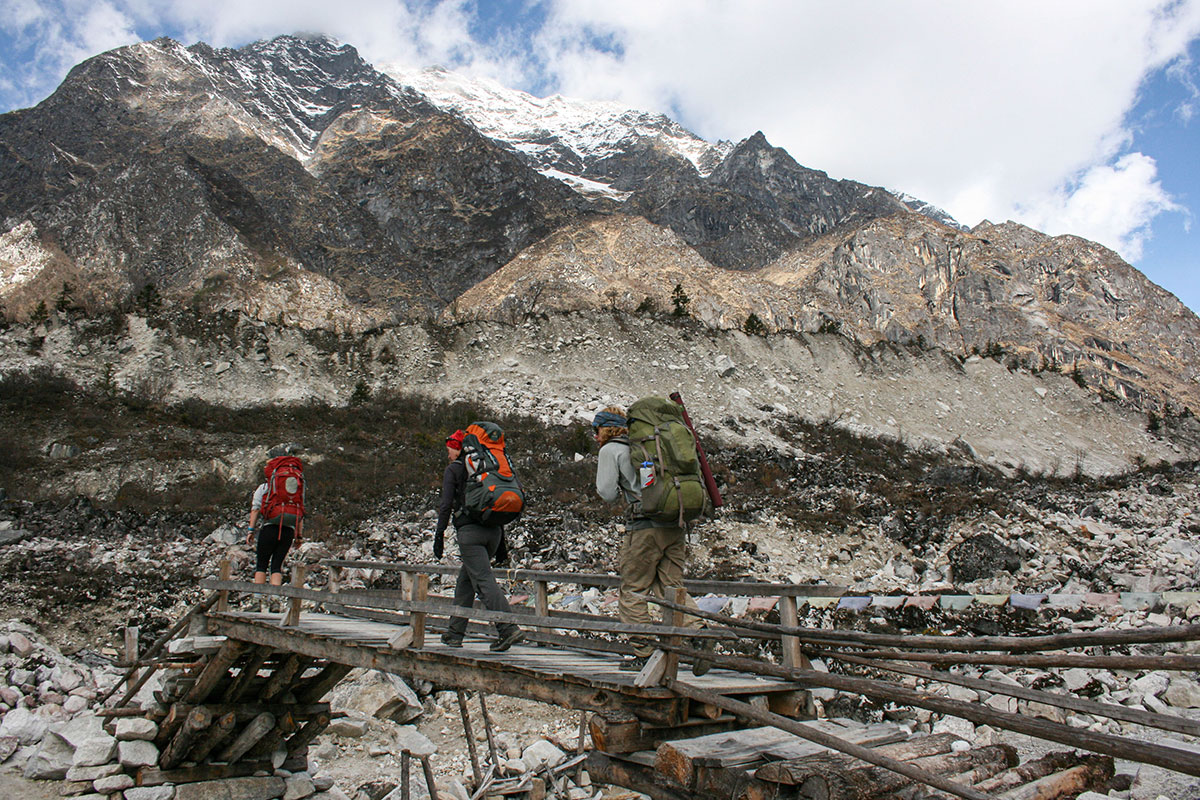
Tsum Valley Manaslu Circuit Trek
22 Days
Just as diverse as the ethnic population, so too the scenery varies from the lush, low elevation valleys growing rice and bananas, inhabited predominantly by the Hindu ethnic groups of Indo-Aryan origin, through rhododendron and bamboo forests, where you begin to encounter communities of Tibeto-Burmese origin who practice Hinduism, Buddhism or a mixture of both.
MANASLU CIRCUIT TREK
19 Days
The Manaslu Circuit Trek over the Larky La Pass is one of Nepal’s best-kept secrets. Following remote trails which are little touched by the modern world and which see relatively few visitors throughout the year, it offers beautiful views of the Himalayan range, with the magnificent Manaslu.
TSUM VALLEY MANASLU CIRCUIT TREK
22 Days
Just as diverse as the ethnic population, so too the scenery varies from the lush, low elevation valleys growing rice and bananas, inhabited predominantly by the Hindu ethnic groups of Indo-Aryan origin, through rhododendron and bamboo forests, where you begin to encounter communities of Tibeto-Burmese origin who practice Hinduism, Buddhism or a mixture of both.
CONTACT US
Let us help you plan the trip of your dreams
Address
GPO Box: 8974 CPC 437
Kathmandu, Nepal.
Nepal Govt. Registration
11881/424 1134/066
Phone
Our Team
Diaries
Featured Trips
Bespoke For You
CONTACT US
Let us help you plan the trip of your dreams
Address
GPO Box: 8974 CPC 437
Kathmandu, Nepal.
Nepal Govt. Registration
11881/424 1134/066
info@himalayanquests.com
Phone
+977 9849 141067

